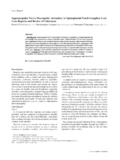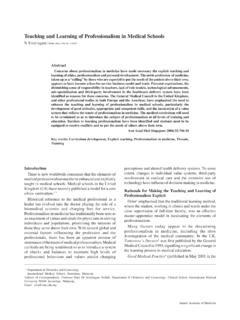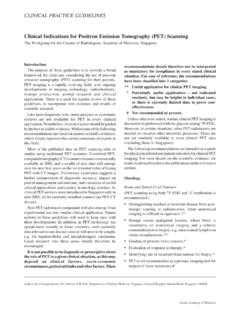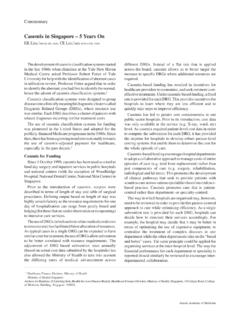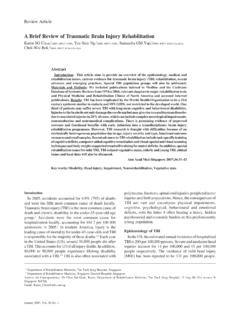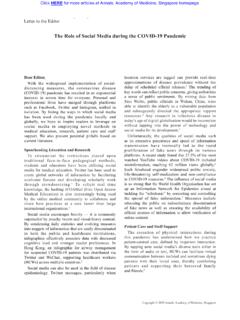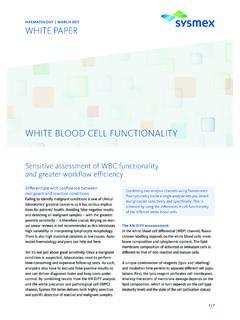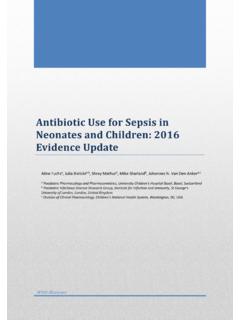Transcription of Therapeutic Leukapheresis in Hyperleukocytic …
1 April 2005, Vol. 34 No. 3229 Leukapheresis for Hyperleukocytic leukaemias D Tan et alTherapeutic Leukapheresis in Hyperleukocytic leukaemias The Experienceof a Tertiary Institution in SingaporeD Tan,1 MBBS, MRCP (UK), M Med (Int Med), W Hwang,1 MRCP (UK), M Med (Int Med), FAMS, YT Goh,1 MBBS, M Med (Int Med), FAMSI ntroductionHyperleukocytic leukaemia is conventionally defined asleukaemia with an initial white blood cell (WBC) count orblast count greater than 100,000 It has a dramaticclinical presentation and represents a very challengingtherapeutic problem due to the high early mortality. Themany early complications and deaths are directly attributedto hyperleukocytosis and its resultant microcirculatorydysfunction, a phenomenon known as leukostasis,2,3 wherethe sludging of leukaemic blasts in capillary vessels andtheir adhesive interactions give rise to deleterious may arise from the involvement of any organsystem, but intraparenchymal brain haemorrhage andrespiratory failure account for the majority of deaths.
2 Therapid destruction of leukaemic cells in response tochemotherapy also causes metabolic disturbances (tumourlysis syndrome).This has led to the notion that prompt leukocytoreductionis imperative in preventing the high incidence ofhyperleukocytic leukaemia-related complications and earlydeaths. As such, Leukapheresis has been widely usedfollowing anecdotal case reports describing striking clinicalimprovements with prompt leukocytoreduction Although introduced more than 20 yearsago,9 there are still no convincing data that Leukapheresis isessential in the immediate treatment of hyperleukocyticleukaemia and the effectiveness of this technique remainsin question. Besides, it is an invasive procedure, requiringexperienced personnel to establish a central vascular the inherent risks of the procedure, additional costsand the lack of data supporting its course, routineleukapheresis cannot be justified and clinicians tend topursue a more conventional approach in children andasymptomatic is recognised that hyperleukocytosis is an unfavourableprognostic factor where higher risk of relapse and shortersurvival rates are commonly ,10-12 Studies on theimpact of Leukapheresis on overall mortality are limited,1 Department of HaematologySingapore General Hospital, SingaporeAddress for Reprints: Dr Daryl Tan, Department of Haematology, Singapore General Hospital, Outram Road, Singapore : Hyperleukocytic leukaemias are associated with early mortality due to respira-tory or neurological complications.
3 They result from endothelial damage secondary to , which aims to lower the white blood cell (WBC) count, has been used in certainpatients to reduce the threat from leukostasis. However, there are very few published clinicalinvestigations on the most appropriate use of Leukapheresis in hyperleukocytosis. Materials andMethods: We performed a retrospective analysis of 14 patients with Hyperleukocytic leukaemiawho presented to our institution and underwent Therapeutic Leukapheresis . We compare theirclinical and biological characteristics and investigate the impact of Leukapheresis on earlymortality and long-term prognosis. Results: The median presenting WBC count was 439 x 103/mm3. Although patients with acute myeloid leukaemia (AML) had the lowest median presentingWBC counts, they constituted the largest group of patients with symptomatic was highly effective, with the mean absolute and percentage reduction in WBCafter each cycle being 126 x 103/mm3 and respectively.
4 Four patients with AML died within2 weeks of presentation despite prompt and effective Leukapheresis . Conclusion: The interactionbetween the leukaemic cells and the vascular environment, a mechanism that none of the currenttherapies directly address, is probably more important in causing leukostasis than the absolutecell count Acad Med Singapore 2005;34:229-34 Key words: Apheresis, Cytoreduction, Hyperleukocytosis, LeukocytoreductionOriginal Article230 Annals Academy of MedicineLeukapheresis for Hyperleukocytic leukaemias D Tan et albut generally concur that it does not improve The impact on early mortality however, iscontroversial. One study reported that leukapheresismanaged to reduce 2-week mortality,13 while anothershowed that despite efficient Leukapheresis , early survivalwas not Herein, we perform a retrospectiveanalysis of patients presenting with hyperleukocyticleukaemia to our institution from 1998 to 2003 and assesstheir clinical outcomes and early mortality rate after and MethodsIn our institution, there is no standing protocol whereleukapheresis should be adhered to for new cases ofhyperleukocytic leukaemia.
5 Decisions on leukapheresisare very much based on the discretion of the attendingphysician and usually, symptomatology and extremes ofleukocytosis (WBC counts of more than 100,000/mm3) arethe main deciding factors. However, patients have to behaemodynamically stable before Leukapheresis can beinstituted. In this retrospective study, we examined theclinical and biological characteristics, and the treatmentoutcomes, including complete remission rate, early mortalityand overall survival, of 14 adult patients with hyper-leukocytic leukaemia who underwent Leukapheresis in ourinstitution during the period of November 1998 to June2003. These patients were identified from the leukapheresislog for the review period and respective case documentswere traced and studied in detail. Diagnoses of theirrespective leukaemias were established on the basis ofmorphological and standard cytochemical examination ofbone marrow smears.
6 Two patients with acute myeloidleukaemia (AML) were unfit for bone marrow studies andhad their diagnoses confirmed on flow cytometry andsmears of the peripheral eligible for Therapeutic Leukapheresis wereidentified at the outset when they presented withsymptomatic hyperleukocytosis. A pheresible catheterwas inserted into the subclavian vein by the attendinghaematologist or the interventional radiologist underradiological guidance if there was a concomitantthrombocytopenia or coagulopathy. Leukapheresis usingdiscontinuous-flow automate instruments (HaemoneticsMCS+ LN 9000) was commenced once correct placementof the pheresible catheter was confirmed from procedure was generally completed within 3 hourswhen 1 calculated total blood volume of the patient wouldhave been pheresed. Overall, Leukapheresis was performeddaily until there was a significant reduction in the WBCcount or until there was sufficient improvement in thepatient s clinical status, allowing initiation of inductionchemotherapy.
7 Prior to the first Leukapheresis cycle,hydroxyurea at doses of 1g to 3 g was started immediatelyfor all patients except for the patient with chroniclymphocytic leukaemia (CLL). All patients also receivedsupportive measures like aggressive intravenous hydrationwith sodium bicarbonate and oral allopurinol so as toprevent or minimise tumour lysis syndrome. Decision todiscontinue Leukapheresis again was based very much onthe discretion of the individual physician. Generally, it wasnot based on WBC counts falling below a certain level, buta downward trend in WBC counts with resolution ofsymptoms of were 14 cases: 7 acute myeloid leukaemias , 3 acutelymphoblastic leukaemias (ALL), 3 chronic myeloidleukaemia (CML) and 1 chronic lymphocytic leukaemia(CLL). The characteristics of patients at presentation aresummarised in Table 1. The median age of the patients years old (range, 15 to 74 years).
8 There were 9 malesand 5 females. The median presenting WBC count was 439x 103/mm3 (range, 175 x103/mm3 to 950 x 103/mm3). WBCcounts causing symptoms were much higher in thelymphocytic leukaemias than the myelocytic ones. Assuch, there were more cases of AML and CML than ALLand CLL who underwent Leukapheresis . It is also remarkablethat although patients with AML had the lowest medianpresenting WBC counts, they constituted the largest groupof patients with symptomatic hyperleukocytosis. The blastcounts in the acute leukaemias generally paralleled theWBC review of their symptomatology (Fig. 1) showed thatall patients had fever and 9 patients presented withneurological symptoms, of which 3 patients had concomitantpulmonary manifestations as well. A common presentingcomplaint amongst patients with chronic myeloid leukaemiawas abdominal pain due to congestive 1. Patients Characteristics at DiagnosisAge (y) * (15-74) Gender (males/females)9/5 Diagnosis:Acute myeloid leukaemia7 Acute lymphoblastic leukaemia3 Chronic myeloid leukaemia3 Chronic lymphocytic leukaemia1 Presenting white blood cell count (x103/mm3):439* (175-950) Acute myeloid leukaemia303*Acute lymphoblastic leukaemia634*Chronic myeloid leukaemia510*Chronic lymphocytic leukaemia950** median value; range of valuesApril 2005, Vol.
9 34 No. 3231 Leukapheresis for Hyperleukocytic leukaemias D Tan et alLeukostasis-defining symptoms involving the respiratoryor central nervous systems were more commonly seen inacute than chronic mean number of cycles of Leukapheresis required byeach patient was (range, 1 to 3). Overall, 25 leuka-pheresis cycles were performed among the 14 patients. Themean absolute and percentage reduction in WBC after eachcycle were 126,000 x103/mm3 (range, 80 x 103/mm3 x 103/mm3) and (range, to )respectively. The median absolute WBC counts afterleukapheresis was x103/mm3. In subgroup analysis,the mean absolute reduction per cycle of Leukapheresis forAML, ALL, CML and CLL were x 103/mm3, x103/mm3, x 103/mm3, and 80 x 103/mm3 respectively,while the mean percentage reduction per cycle were , , and respectively (Table 2). Thisrepresents comparable efficacy of leukocytoreduction byleukapheresis for AML, ALL and CML, where more than30% reductions in WBC were achieved.
10 As there was only1 patient in the CLL subgroup, the low yield seen afterleukapheresis may not be conclusive. Leukapheresis wasgenerally well tolerated. There was only 1 patient whodeveloped hypotension after the procedure and it waseasily reversible with intravenous but 4 patients demonstrated significant symptomaticimprovements. These 4 patients with AML died fromleukostasis-related problems before inductionchemotherapy could be started despite prompt and effectiveleukapheresis. Three died within the first week ofpresentation and 1 in the second week. Severe pulmonaryand neurological manifestations were more prominentamongst the early mortalities. Reasons for early mortalityincluded intracranial haemorrhage and pulmonaryhaemorrhage. There was no early mortality amongst patientsin the other subgroups. Patients who died during the first 2weeks tended to be older. Two AML and all 3 ALL patientsmanaged to achieve complete remission (CR) after inductionchemotherapy.
